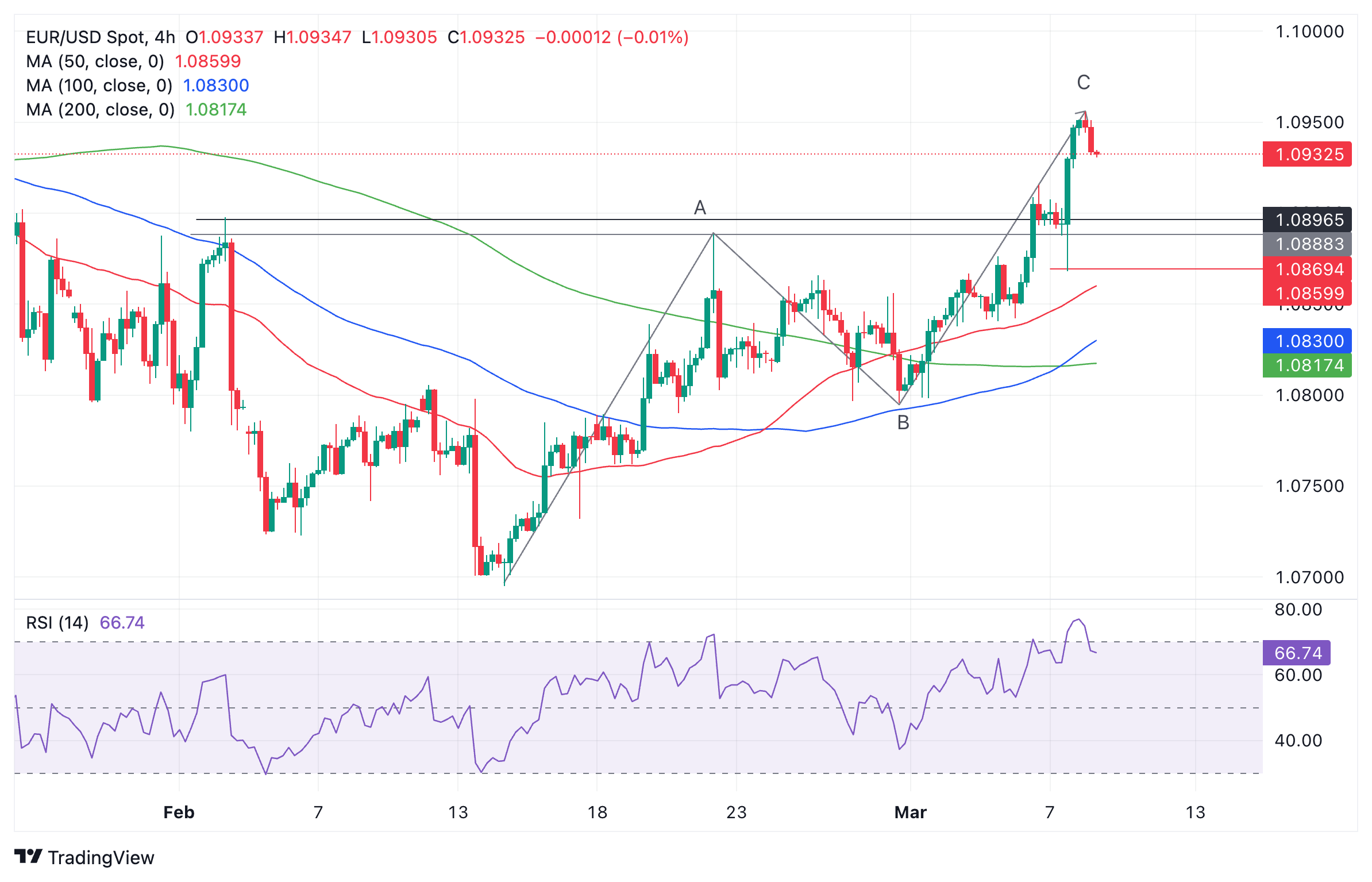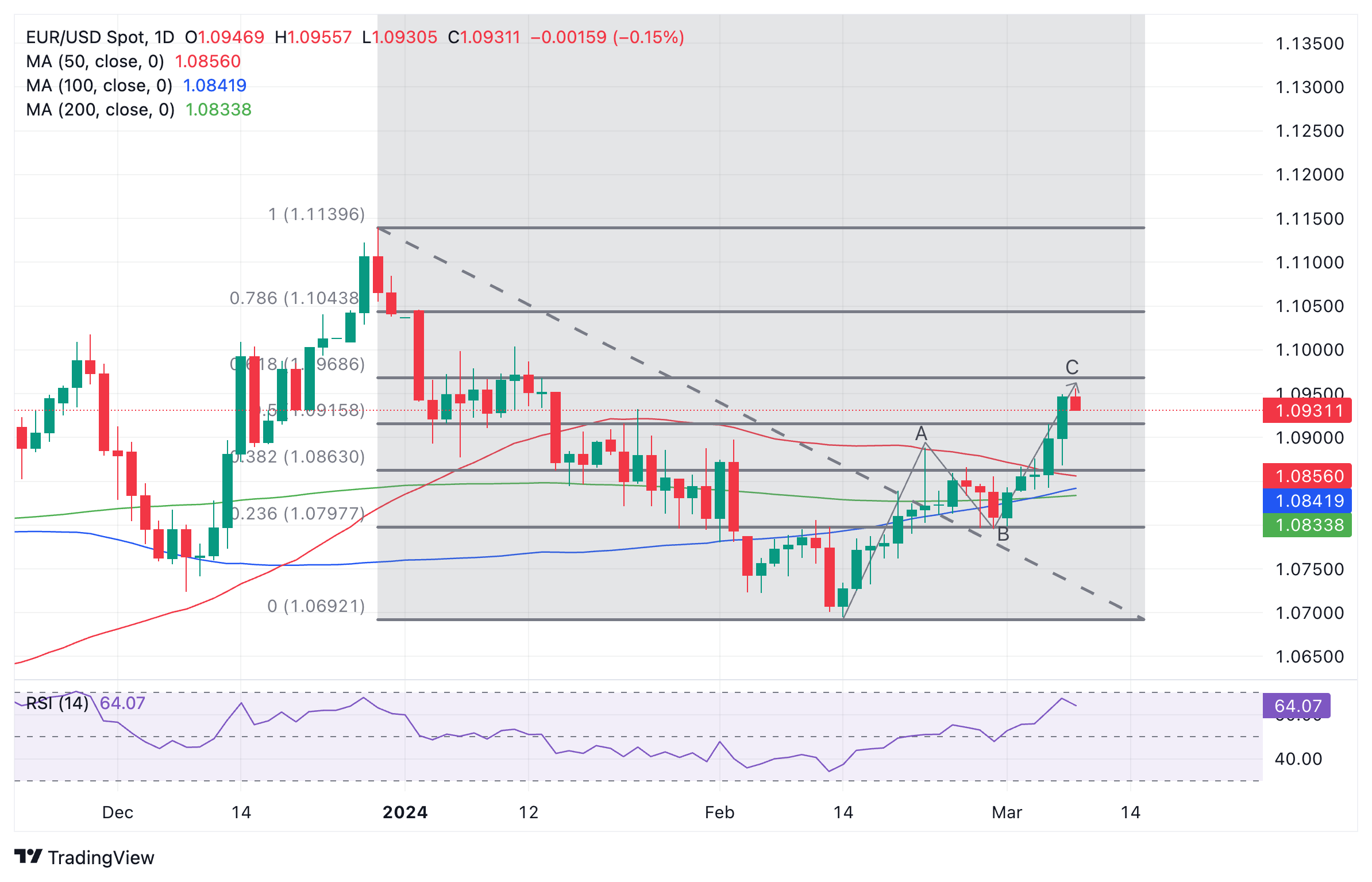EUR/USD corrects on talk of April rate cut, after rallying to within sight of 1.1000

- EUR/USD is correcting back after a surge on Thursday that took it to the mid 1.0900s.
- The pair was boosted by the Fed sounding more likely to cut interest rates than the ECB.
- Comments from ECB officials since have revived the possibility of an early rate cut, weighing on the Euro.
EUR/USD is edging lower as traders book profits ahead of the weekend after a strong performance on Thursday, when bulls knocked on the door of 1.1000 for the first time since early January. The Euro is weakening on Friday, after comments from ECB officials put the possibility of an early interest-rate cut in April back on the table.
EUR/USD corrects back after dovish talk from ECB officials
Governor of the Bank of France and ECB Governing Council member Francois Villeroy de Galua, said a rate cut in spring was now “very likely”, adding, “spring goes from April to June.”
His ECB colleague, Bundesbank President Joachim Nagel, said “The probability is increasing that we could see an interest-rate cut before the summer break,” adding, “This will be data dependent, but the prospects have brightened.”
Their dovish views clash with the more cautious stance of the ECB President Christine Lagarde, who said after the ECB meeting on Thursday, that June would be the next key date for reviewing policy on interest rates. The Euro is declining as lower interest rates reduce the attractiveness of a currency as a place for foreign investors to park their capital.
EUR/USD is broadly speaking in a short-term uptrend, propelled higher by prospects that the US Federal Reserve (Fed) is a fraction closer to lowering interest rates than the European Central Bank (ECB).
Prior to the ECB meeting on Thursday, some analysts had highlighted April as a possible candidate for initiating rate cuts. In her press conference after the ECB meeting, however, European Central Bank President Christine Lagarde said: “We have not discussed rate cuts at this meeting,” suggesting April was off the table. Her other comments indicated the ECB policymakers were not planning to seriously review this possibility until June, after more data is available.
On the contrary, Federal Reserve Chairman Jerome Powell seemed more dovish during his testimony to the Senate Banking Committee on Thursday. Powell said “we’re not far” from inflation falling to a level where it would be okay to start cutting rates.
On the horizon
With the ECB meeting and Powell’s testimony in the rear view mirror, the next key event for the EUR/USD will be US Nonfarm Payrolls (NFP) data, out on Friday at 13:30 GMT.
If US jobs data is soft, in line with the ADP, JOLTS and jobless claims from earlier in the week, it could suggest the time is coming closer to cut interest rates. This would weigh on the USD, giving EUR/USD another boost.
NFPs cannot be easily predicted, however, and are apt to surprise, sometimes going in the opposite direction to previous labor metrics such as ADP. The fact that certain employment-related indicators leading to the key Nonfarm Payrolls release were negative doesn’t mean that NFPs will follow suit.
Analysts are predicting headline Nonfarm Payrolls to come out at 200K extra jobs in February, the Unemployment Rate to remain steady at 3.7%, and the all-important Average Hourly Earnings figure to show 4.4% YoY rise and a 0.3% MoM advance.
Average Weekly Hours are expected to rise to 34.3 from 34.1, suggesting more full-time employees joining the army of US workers – which is generally taken as a positive for the economy and the US Dollar.
Technical Analysis: Euro overbought and pulling back
Turning to the charts, the EUR/USD has risen up to the 1.0900s from February’s base-camp 1.0600 lows. The sequence of rising peaks and troughs suggests that overall a tentative short-term uptrend is in progress, slightly favoring bulls.
There are, however, signs a pullback is unfolding. During the last eight hours, the Relative Strength Indicator (RSI) has exited the oversold zone, giving a sell signal. At the same time, the pair may have completed a three-wave ABC measured move pattern at the recent 1.0956 highs. This is further evidence a correction may be underway.
Euro vs US Dollar: 4-hour chart
Whilst these signs are still not enough to indicate a reversal of the short-term uptrend, they do recommend a pullback is underway. The most likely target for the correction to find support is in a zone between the 1.0898 February 2 high and the top of the A wave at 1.0888.
A break below the red line at Thursday’s 1.0867 lows would indicate a greater chance the pair was reversing.
The daily chart shows the pair is also probably now in an intermediate uptrend, although one pass higher after the current pullback would solidify that view.
Euro vs US Dollar: 1-day chart
The RSI on the daily chart is not as overbought as on the 4-hour and indicates more upside is still possible before the party gets too rowdy.
The next target higher if the uptrend resumes is the key 0.618 Fibonacci retracement of the early 2024 decline, at 1.0972.
A break above that level would further encourage bulls to strike for the prize – 1.10 – an important psychological level, followed by 1.1043 at the 0.786 Fibonacci retracement.
A break beneath the 1.0795 lows would spoil the buyer’s party and indicate a vulnerability to break down.
The overall long-term trend is sideways and remains difficult to forecast.
ECB FAQs
The European Central Bank (ECB) in Frankfurt, Germany, is the reserve bank for the Eurozone. The ECB sets interest rates and manages monetary policy for the region. The ECB primary mandate is to maintain price stability, which means keeping inflation at around 2%. Its primary tool for achieving this is by raising or lowering interest rates. Relatively high interest rates will usually result in a stronger Euro and vice versa. The ECB Governing Council makes monetary policy decisions at meetings held eight times a year. Decisions are made by heads of the Eurozone national banks and six permanent members, including the President of the ECB, Christine Lagarde.
In extreme situations, the European Central Bank can enact a policy tool called Quantitative Easing. QE is the process by which the ECB prints Euros and uses them to buy assets – usually government or corporate bonds – from banks and other financial institutions. QE usually results in a weaker Euro. QE is a last resort when simply lowering interest rates is unlikely to achieve the objective of price stability. The ECB used it during the Great Financial Crisis in 2009-11, in 2015 when inflation remained stubbornly low, as well as during the covid pandemic.
Quantitative tightening (QT) is the reverse of QE. It is undertaken after QE when an economic recovery is underway and inflation starts rising. Whilst in QE the European Central Bank (ECB) purchases government and corporate bonds from financial institutions to provide them with liquidity, in QT the ECB stops buying more bonds, and stops reinvesting the principal maturing on the bonds it already holds. It is usually positive (or bullish) for the Euro.

